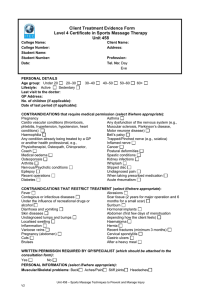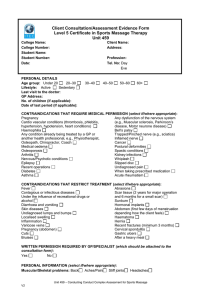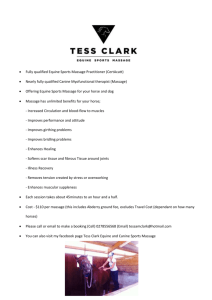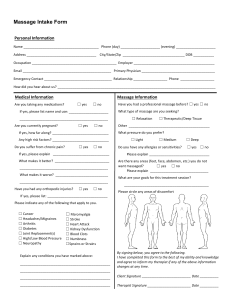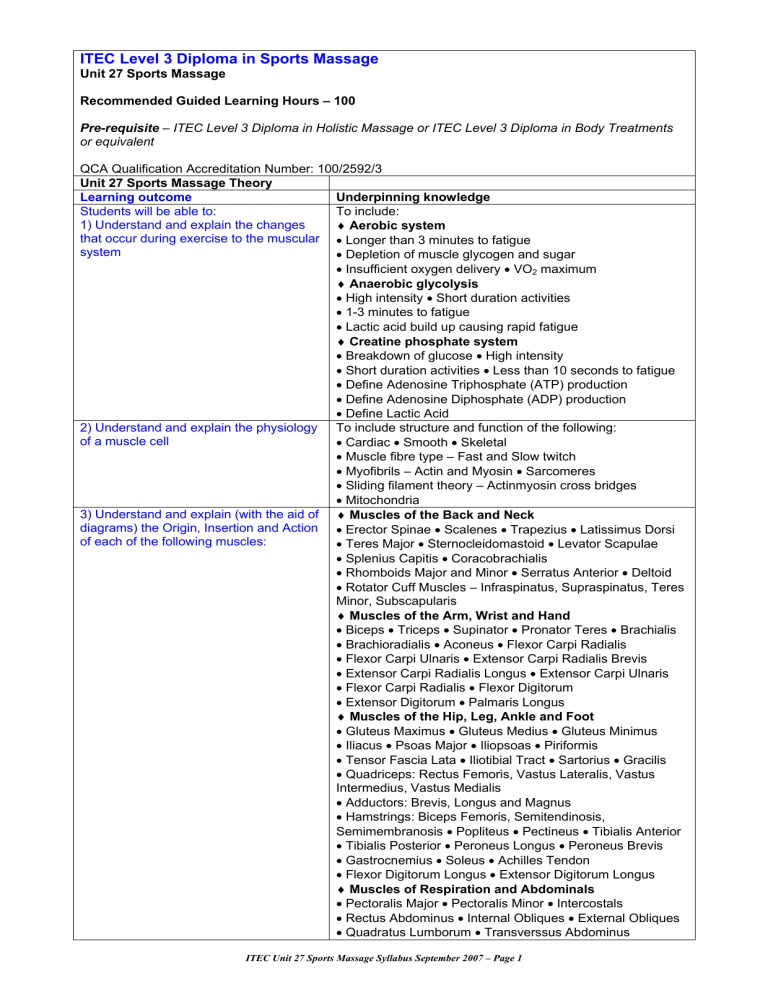
ITEC Level 3 Diploma in Sports Massage Unit 27 Sports Massage Recommended Guided Learning Hours – 100 Pre-requisite – ITEC Level 3 Diploma in Holistic Massage or ITEC Level 3 Diploma in Body Treatments or equivalent QCA Qualification Accreditation Number: 100/2592/3 Unit 27 Sports Massage Theory Learning outcome Underpinning knowledge Students will be able to: To include: 1) Understand and explain the changes ♦ Aerobic system that occur during exercise to the muscular • Longer than 3 minutes to fatigue system • Depletion of muscle glycogen and sugar • Insufficient oxygen delivery • VO2 maximum ♦ Anaerobic glycolysis • High intensity • Short duration activities • 1-3 minutes to fatigue • Lactic acid build up causing rapid fatigue ♦ Creatine phosphate system • Breakdown of glucose • High intensity • Short duration activities • Less than 10 seconds to fatigue • Define Adenosine Triphosphate (ATP) production • Define Adenosine Diphosphate (ADP) production • Define Lactic Acid 2) Understand and explain the physiology To include structure and function of the following: of a muscle cell • Cardiac • Smooth • Skeletal • Muscle fibre type – Fast and Slow twitch • Myofibrils – Actin and Myosin • Sarcomeres • Sliding filament theory – Actinmyosin cross bridges • Mitochondria 3) Understand and explain (with the aid of ♦ Muscles of the Back and Neck diagrams) the Origin, Insertion and Action • Erector Spinae • Scalenes • Trapezius • Latissimus Dorsi of each of the following muscles: • Teres Major • Sternocleidomastoid • Levator Scapulae • Splenius Capitis • Coracobrachialis • Rhomboids Major and Minor • Serratus Anterior • Deltoid • Rotator Cuff Muscles – Infraspinatus, Supraspinatus, Teres Minor, Subscapularis ♦ Muscles of the Arm, Wrist and Hand • Biceps • Triceps • Supinator • Pronator Teres • Brachialis • Brachioradialis • Aconeus • Flexor Carpi Radialis • Flexor Carpi Ulnaris • Extensor Carpi Radialis Brevis • Extensor Carpi Radialis Longus • Extensor Carpi Ulnaris • Flexor Carpi Radialis • Flexor Digitorum • Extensor Digitorum • Palmaris Longus ♦ Muscles of the Hip, Leg, Ankle and Foot • Gluteus Maximus • Gluteus Medius • Gluteus Minimus • Iliacus • Psoas Major • Iliopsoas • Piriformis • Tensor Fascia Lata • Iliotibial Tract • Sartorius • Gracilis • Quadriceps: Rectus Femoris, Vastus Lateralis, Vastus Intermedius, Vastus Medialis • Adductors: Brevis, Longus and Magnus • Hamstrings: Biceps Femoris, Semitendinosis, Semimembranosis • Popliteus • Pectineus • Tibialis Anterior • Tibialis Posterior • Peroneus Longus • Peroneus Brevis • Gastrocnemius • Soleus • Achilles Tendon • Flexor Digitorum Longus • Extensor Digitorum Longus ♦ Muscles of Respiration and Abdominals • Pectoralis Major • Pectoralis Minor • Intercostals • Rectus Abdominus • Internal Obliques • External Obliques • Quadratus Lumborum • Transverssus Abdominus ITEC Unit 27 Sports Massage Syllabus September 2007 – Page 1 4) Understand and explain the effects of stress on muscles during sport 5) Understand and explain the changes that occur during exercise to the neurological system 6) Describe in detail joint structures 7) Understand and explain the possible stresses and strains put on the spine and other joints in sporting activities 8) Understand and explain in detail (with the aid of diagrams) the joint supporting systems 9) Understand and explain the possible causes and effects of the following diseases and disorders and their effect on specific sports: 10) Understand and explain the principles of training 11) Understand and explain over training 12) Understand the principles of force and motion 13) Understand and explain the principles of injury prevention and management To include ‘Fear, Fight and Flight’: • Adrenal cortex and medulla stimulated to secrete adrenaline • Increase blood to the muscles • Liver stimulates secretion of glucose for anaerobic energy production • Salivary glands vasoconstrict • Pupils dilate • Digestive system slows down preventing energy wastage • ‘Butterflies’ To include: • Change in motor units – Stimulation dependant on number of motor units contracting • ‘Fear, Fight and Flight’ • Hypothalamus stimulates the Sympathetic Nervous System and the Endocrine System – Adrenaline • Cardiorespiratory System speeds up • Blood is diverted to the muscles • Digestive system slows down preventing energy wastage • Liver secretes glucose for anaerobic energy production • Salivary glands vasoconstrict • Pupils dilate • ‘Butterflies’ To include: • Synovial joints • Cartilage – Articular (Hyaline) • Ligaments • Synovial membrane • Bursa To include: • Inflexibility • Lifting techniques • Postural techniques • Stress • Environment • Injury To include the following major joints: • Atlanto-occipital • Atlanto-axial • Shoulder • Sternoclavicular • Elbow • Wrist • Hand • Hip • Sacro-iliac • Knee • Ankle • Foot To include: • Osteo Arthritis • Rheumatoid Arthritis • ‘Shin splints’ • Stress fractures • Facet joint pain • Carpal Tunnel Syndrome • Rotator cuff injuries • Chondromalacia patellae • Calcaneal bursitis • Periostitis • Concussion • Cramp • Stitch • Chronic muscle fatigue • Sprain • Strain • Lateral epicondylitis • Medial epicondylitis • Adhesive capsulitis • Dislocation • Fractures • Ruptured muscles • Jogger’s nipple • Torn cartilage • Fibrositis • Fibrosis • Impingement • Muscle soreness • Atony • Atrophy • Fasciitis • Myositis • Tendinitis • Spasm • Soft Tissue Injuries • Exercise induced Asthma • Diabetes • Hay Fever • Hyperventilation • Osteoporosis • Low Back Pain • Heartburn • Irritable Bowel Syndrome • Haemorrhoids • Hernias •Amenorrhoea • Heat stroke • Heat exhaustion • Kidney stones • Dehydration • Torticollis • Myalgia • Myotonia • Black toe nails • Runner’s knee • Plantar fasciitis • Osgood Schlatters • Compartment syndrome To include: • Frequency • Intensity • Duration • Overload • Specificity – sport and individual • Reversibility ♦ Define over training To include: • Persistent muscle soreness • Loss of co-ordination • Prolonged fatigue • Dizziness • Performance inconsistency • Elevated resting heart rate • Tightness in the chest • Heat stress To include: ♦ Motive and Resistive forces • Concentric • Eccentric • Isometric contractions To include: ♦ Components of fitness • Stamina • Suppleness • Strength • Speed • Skill ITEC Unit 27 Sports Massage Syllabus September 2007 – Page 2 14) Understand and explain the stages of the healing process and the possible treatments available 15) Understand the preventative and rehabilitative training to reinforce massage treatments 16) Understand the effects and benefits of stretching 17) Understand and explain the use of stretching massage movements 18) Understand and explain the signs and symptoms of inflammation 19) Understand and explain the techniques of thermotherapy and cryotherapy(ICER) and the rationale for choice 20) Understand and explain scar tissue and adhesions 21) Understand and explain the possible damage to the skin as a result of sporting activities on different types of surfaces, with regard to clothing, shoes, exposure to the sun, wind and other elements • Specificity • Psychological aspects • Define Warm up/Cool down ♦ Intrinsic/Personal • Age • Sex • Somatotype • Biomechanics ♦ Fitness to include • Muscle balance • Physical symmetry • Joint integrity • Motor skills • Psychological factors ♦ Extrinsic/Environmental • Organisation and Management • Type of sport • Training errors • Environment • Equipment To include: • Acute/inflammatory phase • Repair phase • Remodelling phase To include • Passive • Active • Resistive forms of exercise and the frequency and duration of each • Intensity • Use of Free Weights and/or Resistive bands where appropriate • Importance of Warm up/Cool down To include: • Mental relaxation • Muscular relaxation • Increased flexibility • Improved posture • Prevention of lower back pain • Improved fitness • Relief of muscle soreness • Relief of cramp • Improved motor skills • Prevention of injury To include: • Connective Tissue Massage (CTM) • After injury • Muscle reflexes preventing stretching overload Define inflammation to include: • Increased temperature • Redness • Swelling • Pain • Loss of function ♦ Define thermotherapy to include the use of: • Heat Pad • Hot Compress for pain relief • Increased elasticity of collagen fibres ♦ Define cryotherapy to include the use of: • Ice for relief of pain • Constriction of blood vessels • Reduction of swelling • Reduction of metabolism • Reasons for contrast bathing • Define Scar tissue • Define Adhesions To include: • Blisters • Grazes • Sores • Open wounds e.g. Lacerations • Puncture wounds • Abrasions • Gravel burns • Sun burns • Wind burns • Bruising Surfaces include: • Grass • Gravel • Astroturf • Stone • Wood ITEC Unit 27 Sports Massage Syllabus September 2007 – Page 3 22) Understand, explain and demonstrate methods of consultation 23) Understand, explain and demonstrate how to record information and store in a safe place and secure manner 24) Understand and recognise contraindications to sports massage with reasons why and when to refer to other health professionals An example of a consultation form can be found at www.itecworld.co.uk Students should demonstrate knowledge of the importance of the following: • Private comfortable area • Positive body language • Positioning of the client (no barriers between themselves and client) • Good communication skills (asking open and/or closed questions where appropriate) • Trust • Professionalism, confidence and enthusiasm • Confidentiality • Any contraindications to treatment • Client profile • Importance of planning a treatment programme bearing in mind the clients religious, moral and social beliefs • Determining the nature and extent of the clients needs • Agreement to the course of action • Ascertain the clients consent to the treatment (where the client is not in a position themselves ascertain from the appropriate companion’s agreement to the treatment) • Explanation of any possible side effects to the treatment • Explanation how the programme will be evaluated and the review process • Where applicable clarify with the client information, which may be available to other, e.g. relevant health care workers • Obtain the client’s signature (or that of the companion) ♦ Physical examination including: • Head • Shoulders • Back • Pelvis • Legs • Feet • Body alignment/Posture • Range of motion/Joint function • Comparison of strength of the muscles on each side of the body • Muscle definition • Active, Passive and Resisted movement • Palpation To include: • Any contraindications • Area treated • Type of injury • Treatment given • Any reactions • Any exercises given • Home care treatment ♦ Never treat unless the injury has been diagnosed and treatment has been recommended by a medical practitioner • Pregnancy • Cardio vascular conditions (thrombosis, phlebitis, hypertension, hypotension, heart conditions) • Haemophilia • Any condition already being treated by a GP or another health professional, e.g. Physiotherapist, Osteopath, Chiropractor, Coach • Medical oedema • Osteoporosis • Arthritis • Nervous/Psychotic conditions • Epilepsy • Recent operations • Diabetes • Asthma • Any dysfunction of the nervous system (e.g. Muscular sclerosis, Parkinson’s disease, Motor neurone disease) • Bells Palsy • Trapped/Pinched nerve (e.g. sciatica) • Inflamed nerve • Cancer • Postural deformities • Spastic conditions • Kidney infections • Whiplash • Slipped disc • Undiagnosed pain • When taking prescribed medication • Acute rheumatism ♦ Contraindications that restrict treatment • Fever • Contagious or infectious diseases • Under the influence of recreational drugs or alcohol • Diarrhoea and vomiting • Skin diseases • Undiagnosed lumps and bumps • Localised swelling • Inflammation • Varicose veins • Pregnancy (abdomen) • Cuts • Bruises • Abrasions • Scar tissues (2 years for major operation and 6 months for a small scar) • Sunburn • Hormonal implants ITEC Unit 27 Sports Massage Syllabus September 2007 – Page 4 25) Understand, explain and ensure appropriate client care, client modesty and the correct use of towels at all times 26) Understand, explain and demonstrate correct hygiene procedures 27) Understand, explain and demonstrate the ability to ensure client is in a suitable position of comfort and support for different techniques applied to different parts of the body and range of conditions 28) Understand, explain and demonstrate the skills of palpation and physical examination compared with pre-massage states to measure the following: 29) Understand, explain and demonstrate the application and removal of the medium if required, appropriately and professionally 30) Understand and explain the effects of massage on muscle and other soft tissue 31) Understand, explain and demonstrate the classical massage movements where appropriate 32) Understand and explain the reasons for selecting the appropriate type of massage movement according to the client’s conditions and needs • Abdomen (first few days of menstruation depending how the client feels) • Haematoma • Hernia • Recent fractures (minimum 3 months) • Cervical spondylitis • Gastric ulcers • After a heavy meal To include: • Checking consultation and contraindications • Explaining the treatment to the client • Helping the client onto the couch/seat protecting the client’s modesty at all times • Ensure that all parts of the client are covered except the area being massaged • Cleanse the feet with a medi-wipe or similar • Wash own hands • Keep ensuring that the client is comfortable • Remove the massage medium at the end of the treatment if appropriate • Help the client off the couch/seat protecting their modesty at all times ♦ Describe the most efficient form of sterilisation: • In the sports clinic • In situ at a sports event ♦ Describe the best form of waste removal (particularly when contaminated): • In the sports clinic • In situ at a sports event • Reasons for good personal hygiene • Wash own hands • Wipe the clients feet • Use clean towels for each client • Put couch roll on top of towels • Wear clean white professional work wear • Socks/tights and full flat shoes • Remove all jewellery (except wedding band) from self and client • No nail enamel • Clean short nails • Hair tied back off collar and face • Use appropriate supports e.g. under the ankles, chest and forehead, knees, head, or wherever a support is appropriate for the sports massage movement • Passive, Active and Restricted Movement • Range of Movement • Degree of Swelling • Variations in Tissue Temperature • Muscle Tone and Bulk • Adhesions • Previous injury to the area • Fatty Nodules • Ensure the massage medium is removed at the end of the treatment if required • Do not let the client walk around in bare feet • Ensure all surfaces are lined with couch roll • Wipe couch and trolley with surgical spirit or similar at the end of each day To include: • Speeds up healing of damaged tissues and muscles • Increases fitness capabilities • Increases performance potential • Prevents future injury • Helps clear out waste and toxins • Breaks up adhesions • Enables faster healing • Improves flexibility • Enables peak performance to be achieved more rapidly To include: • Effleurage • Petrissage • Frictions • Tapotement • Vibrations • Specific Sports Massage Techniques • Movements should be performed correctly and on areas appropriate for the injury and the clients needs To include: • Effleurage • Petrissage • Frictions •Tapotement • Vibrations • Specific Sports Massage Techniques ITEC Unit 27 Sports Massage Syllabus September 2007 – Page 5 33) Understand, explain and demonstrate sports massage techniques according to the clients condition and needs. 34) Understand and explain specific Sports Massage techniques for the following: 35) Understand, explain in detail and demonstrate the common sports injuries that can be treated after medical approval 36) Understand, explain and provide feedback and reassurance to the client 37) Understand, explain and advise on the use, application and benefits of self treatment 38) Understand, explain and demonstrate the heat sensitivity test 39) Understand, explain and provide feedback and reassurance of the client To include: • Manual Lymphatic Drainage • Neuro-Muscular Technique (NMT) • Muscle Energy Technique (MET) • Soft Tissue Release (STR) • Connective Tissue Massage (CTM) • Proprioceptive Neuromuscular Facilitation (PNF) • Treatment of injury • Pre-event • During/Between event • Post event • Corrective • Preventative • Conditioning massages To include: • ‘Shin Splints’ • Ilio tibial band release (Runner’s knee) • Muscle fatigue • Lateral epicondylitis • Medial epicondylitis • Soft tissue injuries • Sprains • Rotator cuff injuries • Strains • Muscle soreness • Cramp • Myositis • Spasm • Stitch • Fibrositis • Fibrosis • Atony • Atrophy • Hyperventilation • Low back pain • Carpal tunnel syndrome • Calcaneal bursitis • Chondromalacia patellae • Adhesive capsulitis • Torticollis Tendinitis of any muscle including: • Achilles • Flexor • Biceps • Supraspinatis • Subscapularis • Tibialis Anterior Superficial skin wounds including: • Blisters • Grazes • Sores • Open wounds e.g. Lacerations • Puncture wounds • Abrasions • Gravel burns • Sun burn • Wind burn ♦ At the end of each treatment the client’s feelings and any skin or other reactions should be recorded The following areas should be monitored: • Outcomes achieved • Effectiveness of the treatment • Any change in demands • Whether the treatment met the needs of the client • Longer term needs of the client • Encourage clients to express their feelings/requirement during the treatment • Note client’s reactions and make appropriate adjustments To include: • Thermotherapy • Cryotherapy • The use of alternating hot and cold test tubes on the appropriate part of the body ♦ At the end of each treatment the client’s feelings and any skin or other reactions should be recorded The following areas should be monitored: • Outcomes achieved • Effectiveness of the treatment • Any change in demands • Whether the treatment met the needs of the client • Longer term needs of the client • Encourage client to express his/her feelings/requirements during the treatments • Note client’s reactions and make appropriate adjustments ITEC Unit 27 Sports Massage Syllabus September 2007 – Page 6 Unit 27 Sports Massage Case Studies 5 clients must be treated 3 times each to make a total of 15 treatments To include: • Consultation including thorough medical history and general lifestyle • Client profile (to include any current issues in their life) • Rationale for the choice of treatment • Details of how the therapist conducted the treatment • Details of how the client felt during and after the treatment • Details of home care advice given ♦ The following should also be documented for treatments 2 and 3 : • The consultation should be checked and any changes noted • Rationale for the choice of treatment • Details of how the therapist conducted the treatment • Details of how the client felt during and after the treatment • Details of home care advice given • An overall conclusion of the case should be recorded • Reflective practice after each treatment* • Signed by client *NB: Candidates should reflect on their own performance and the performance outcomes of the treatment ITEC Unit 27 Sports Massage Syllabus September 2007 – Page 7 Mapping of Key Skills Unit 3 to ITEC Level 3 Unit 27 Sports Massage IT3.1 Plan and use different sources to ♦ Understand and explain methods of consultation search for and select information required Students are required to research and design a consultation for two different purposes form to be used for producing their case studies. Candidates may use a computer for this purpose. ♦ Understand and explain the issues surrounding consent, to include writing to GPs and other medical practitioners for ‘consent’ to treatment Students are also required to understand the importance of producing a standard letter to send to GPs or other medical practitioners for consent to treatment. As students are required to study anatomy and physiology in detail, candidates may use the internet for researching the subject IT3.2 Explore, develop and exchange ♦ Candidates are required to produce 15 case studies, i.e. information and derive new information to they must treat 5 clients 3 times each, including taking a full meet two different purposes consultation using their own form, gaining written consent where applicable, treatment plan, obtain information as to how the client felt before during and after the treatment and giving good after care advice. A computer may be used for this purpose. IT3.3 Present information from different ♦ Understand and explain methods of consultation sources for 2 different purposes and Students are required to research and design a consultation audiences form to be used for producing their case studies and a Your work must include one example of computer may be used for this. text, one example of image and one ♦ Understand and explain the issues surrounding consent example of numbers To include writing to GPs and other medical practitioners for ‘consent’ to treatment IT skills may be used for this purpose. C3.1a Contribute to a group discussion Throughout the course the use of sports massage techniques about a complex subject and their effects will be discussed in relevance to a variety of specific sports injuries and required case studies C3.2 Read and synthesise information Students are required to understand the structure and from two extended documents about a function of the human body in detail in order to understand complex subject the effects of specific sports injuries, therefore they are One of these documents should include at required to read around the subject and research form the least one image books on the ITEC recommended book list. They are also required to draw diagrams from memory of the human body and specifically the muscular system, joints and the possible reasons for the injuries ITEC Unit 27 Sports Massage Syllabus September 2007 – Page 8 Mapping of other issues for ITEC Level 3 Unit 27 Sports Massage This unit deals with clients being consulted prior to selecting the appropriate sports massage treatment according to their requirements. As such, ethical issues are often raised relating to the massage treatment, the surroundings and whether the client should or should not be treated. For example: Understand, explain and demonstrate methods of consultation Understand, explain and demonstrate knowledge of the contraindications to sports massage and when to refer to other health professionals Understand, explain and ensure appropriate client care, client modesty and the correct use of towels at all times Social issues are often raised relating to the individual treatment of the client and ensuring that they are treated in an appropriate and acceptable way depending upon their particular cultural or religious background and the treatment being administered For example: Understand, explain and demonstrate the ability to ensure client is in a suitable position of comfort and support for different techniques applied to different parts of the body and range of conditions Understand, explain and provide feedback and reassurance to the client Understand, explain and ensure appropriate client care, client modesty and the correct use of towels at all times As the students will be working in a ‘clinic environment’ they must ensure that it is safe and hygienic for themselves and any visiting clients. They must also ensure that it complies with the Health and Safety regulations and the Electricity at Work Act and that they never treat clients who may be contraindicated For example: Understand, explain in detail and demonstrate the common sports injuries that can be treated after medical approval Understand, explain and demonstrate correct hygiene procedures Understand, explain and demonstrate knowledge of the contraindications to sports massage and when to refer to other health professionals ITEC Unit 27 Sports Massage Syllabus September 2007 – Page 9
